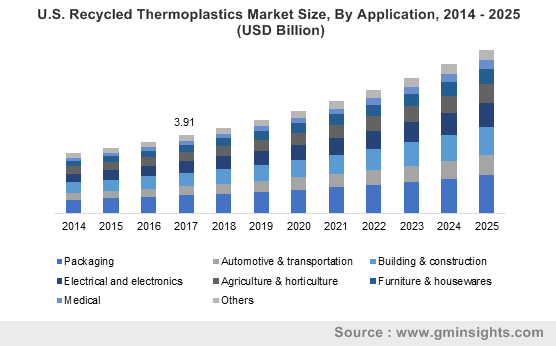Recycled Thermoplastic Market to witness momentous growth owing to the application in construction industry, APAC to be the leading market by 2025
Publisher : Fractovia | Published Date : July 2018Request Sample
Driven by a renewed approach by the packaging industry towards using more eco-friendly options, global recycled thermoplastic market has established itself as one of the most lucrative business verticals of recent times. The fraternity was valued over USD 45 billion in 2017, primarily driven by constricting government reforms to curb non-degradable plastic utilization and a renewed approach by the packaging industry towards using more eco-friendly options. The distinctive ability to be repeatedly melted and remolded multiple times is the foremost characteristic of thermoplastics, said to be 100% recyclable and aptly suited for varied areas where plastic products are used and disposed off in a short span of time.
Recycled thermoplastic market has been critical in propagating the manufacture of recycled bottles, trays, pots and bins that are light, strong, have good resistance to impact and moisture and can be reprocessed by recycling plants. Vital properties like corrosion resistance, low-density, high-strength and flexibility of design are fueling the growth of the recycled thermoplastic market.
U.S. Recycled Thermoplastics Market Size, By Application, 2014 – 2025 (USD Billion)

An undeniable fact affecting the worldwide opinion on plastics is the ecological concerns emanating from the waste disposal methods, specifically the pollution from landfill and incineration. A report by the National Geographic has stated that since the manufacturing of plastic products commenced six decades ago, up to 8.3 billion metric tons of plastic has been produced till now. Distressingly, out of that around 6.3 billion metric tons of plastic has been turned to waste. The astonishing number is a cue for government agencies to enforce laws and regulations directing the efforts for producing biodegradable products, which will subsequently boost the recycled thermoplastic market.
Fundamentally, biodegradable thermoplastics are based on raw materials such as starch, cellulose, polylactic acid and other natural polymers that are renewable sources and will always be available. Being recyclable, these thermoplastics can be re-used to make films, packaging materials, coatings and construction materials. Easily sourced natural raw materials and increased R&D investments towards enhancing their quality has proliferated the biodegradable recycled thermoplastic market, which apportioned the highest revenue share of more than USD 40 billion in 2017.
An expanding area of viability for the recycled thermoplastics industry is the construction segment, where composites are being fashioned to replace traditional building materials like wood, aluminium and other metals. Construction composites are very effective in terms of strength, flexibility, durability and cost-efficiency, motivating industry players to innovate different ways to produce them including the recycle of thermoplastics. For instance, polystyrene waste from packaging is recycled into plastic wood while HDPE and LDPE from industrial and domestic waste is recycled to obtain mixed plastic sheets used on outdoor equipment. It is found that these composites made from recycled plastic last five times longer than treated timber and hardly have any replacement or maintenance costs. In addition to the construction sector, automobile and transportation industry is also becoming a hotspot for the recyclable thermoplastic market.
The stringent government legislations for safer and more economical vehicles has inherently increased their overall weight, pressuring automakers into finding lighter and greener replacement for essential vehicle parts. Luxus, a U.K. based recycling company has been providing recycled thermoplastic materials for the automobile market to many prominent OEMs including Nissan, Honda, BMW among others. Company records show that traditionally, Luxus supplied mostly non-visual or under the hood components to the manufacturers whereas at present even components for visual parts such as glove boxes and door panels are being produced. The steady ascent of consumer spending on cars has given the automobile industry a massive thrust, creating an alternate revenue platform for the recycled thermoplastic market.
In terms of profitability potential, one cannot ignore the regional dominance of Asia-Pacific as a consumer for the recycled thermoplastic industry. Governments in Asian countries are adopting highly restrictive acts to promote recyclable materials and the effect can also be felt in sectors other than automobile manufacturing. India and China are witnessing tremendous amounts of construction projects to cater to the rising population and supplement large scale industrialization of multiple segments, presenting a big market for recycled composites. Add to it, agrarian countries like India are experiencing an upward movement in development activities supported by government initiatives and will push the demand for recycled thermoplastic materials used in agricultural pipes, canals, irrigation systems and green housings. Derived from the aforementioned factors, the Asia-Pacific region is anticipated to lead the recycled thermoplastic market, holding 35% of the global share by 2025.
Key product advantages like easy sourcing, cost-effectiveness, material strength and being environment-friendly will certain propel the recycled thermoplastic market worldwide, with a CAGR of over 9.5% estimated for 2018 to 2025. Plastipak Holdings, RJM International, Inc., PARC Corporation, Revital polymers and KW Plastics are some established players in the extremely competitive recycled thermoplastic industry.